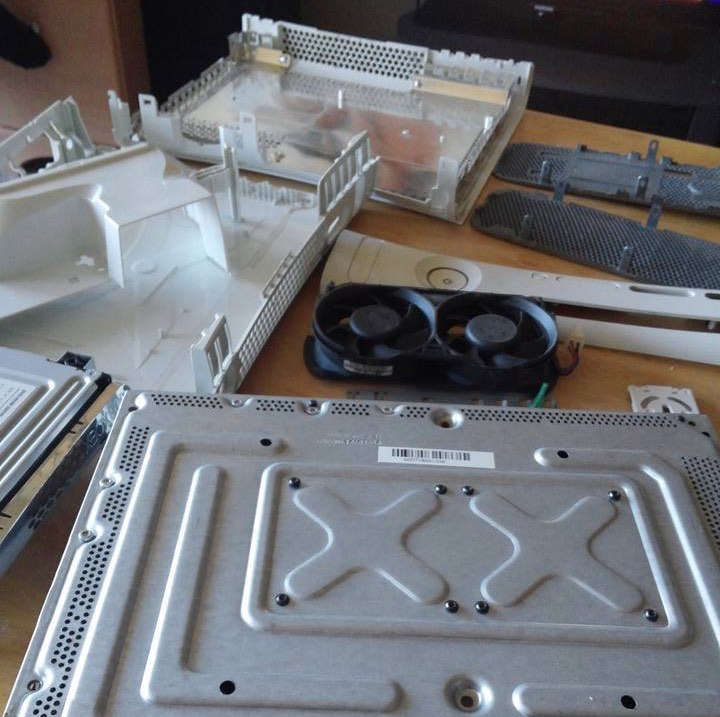
My name is Mem. And I’m a gamer. For me, gaming isn’t just a hobby—it’s part of my identity. Over the years, my fiancé and I have collected a dragon’s hoard of games and consoles. Amongst the collection: a much-used, much-beloved Xbox 360. But after years of heated gaming sessions, our trusty old Xbox overheated and stopped working altogether. Ah, the Red Ring of Death—the scourge of the Xbox 360, destroyer of gaming dreams.
We exiled our toasted console to the closet, but I just couldn’t bring myself to throw it away—I’m sentimental like that. To me, each console is also a collection of memories: the glorious unboxing process, afternoons gaming with friends, hard-won victories over marauding monsters.
I couldn’t junk a console that meant so much to me. Especially when junking the console also meant junking the games. The 360’s successor, the Xbox One, is not backward compatible. Upgrading to an expensive new Xbox meant I’d also have to buy a whole new set of games—and I’d never be able to revisit the old gaming worlds I loved. So our old Xbox 360 collected dust in a closet. Tired. Alone. Broken.
And that’s probably how it would have stayed. But then I came to work at iFixit. And I learned that I could fix my game console myself.
I’ll be honest: even though I wanted my 360 back, it was a month before I attempted the fix. I believe in iFixit’s mission, and I believe in repair—but, like a lot of first-time fixers, I didn’t really believe in myself. “I can’t fix this,” I thought to myself. “I’m only going to make it worse!”
But I then realized, the Xbox was already broken. No one was using it. I had nothing to lose. So I picked a day, set up the living room table, broke out my Pro Tech Toolkit, and opened up the Red Ring of Death Fix Kit. I pulled up the Red Ring of Death (RROD) repair guide and took a deep breath. Here was my next big battle as a gamer.
Doing a complete 360

My nerves rose as I started the complicated process of getting the Xbox free from its case. It took some time, but the Xbox tools made it easy. Once inside the console, however, I encountered my first hiccup: the X-clamps refused to come undone (I broke one of my screwdriver bits trying). I was terrified of prying too hard and breaking the board. So I took a breather, watched the video guide, and tried again. This time I was able to free the X-clamps from the board, releasing the GPU heat sink and the CPU.
Next, I removed the thermal paste and used a heat gun to reflow the Xbox 360 motherboard. Then I reattached the heat sinks to the motherboard. Finally, I turned my attention to the thermal pads—and boy, did those old pads need replacing.

They were super dusty and slightly warped by heat. By this time, that old fear monster was fading. I got this, I told myself. I can fix this thing. Following the instructions backward, I closed up the 360. My first repair: Done.
Sometimes, the repair is the easy part
And now, the moment of truth. I turned on the Xbox and was greeted with … a red light. No! I thought I did everything right—and it was still broken. My first impulse was to quit. But the gamer in me doesn’t easily concede defeat—the Red Ring wasn’t going to claim another victim today. That’s when I noticed that this particular red light looked different than my old red ring. Time to hit the troubleshooting forums. After a little hunting around, I found my answer: It turns out the Xbox 360 doesn’t like being plugged in and powered on without video cables. So, I hooked the cables into the TV and tried again.
It powered on! Now to test out the system. I grabbed an Xbox game and pressed the eject button … and nothing. Pressed again … nothing. The drive was stuck. Carefully, I pried on the tray tabs. Once the tray was removed, I was able to clean and align the disk tray correctly. I plugged the system in again. It turned on! I tested the drive. It opened! I grabbed a copy of Halo 3. And … nothing—just a message telling me to insert an Xbox 360 disk.
My heart fell. After all that, it won’t read my games? Back to the forums! Turns out my error message could be one of several things. I ran through the possible culprits. Cables connected properly? Yep. Turn it off and on again? Check. Update your system? Well, that’s something. I hadn’t turned on the system for months—it probably needed an update.
I installed the system update and tried the game again—same error. By then, I was mad. Now what am I suppose to do? My fiancé reminded me that even after every system update, the console needs a reset. Might as well give that a shot, too. My anxiety was through the roof. Please work, please…
And then, Halo 3 appeared on screen in all its glory.
It works! It works! It works! My system was back online, and running. The repair took the whole afternoon, caused me a boatload of repair anxiety, and gobbled up one of my screw bits—but dammit, I fixed that Xbox. Of course, the RROD is a notoriously chronic problem—and there’s no guarantee that my system won’t overheat again. But to me, the repair was worth the time and effort.
Because now I know that if I have to do it again, I can. And it’ll be quicker and easier than it was before. Even better: As I revisited Halo 3 on my brand spankin’ fixed Xbox, I was overwhelmed with a sense of pride. I brought my console back to life. I didn’t give up—even when everything seemed to be going wrong. I resisted Microsoft’s upgrade cycle. I defeated obsolescence. And I rescued games I wouldn’t have been able to play again on a newer system.
My name is Mem. And I’m gamer. But now, I’m a fixer too. And that first repair will live on in my memory as the hardest, but also the most meaningful repair ever. Because it changed something for me. It erased the fear I’ve always had about DIY console repair and maintenance. And slaying that monster is the biggest victory of all.
Here’s the guide I used to fix my Xbox 360. Check it out. Bet you can un-RROD your Xbox, too.
This post was originally published Feb. 17, 2015. We’re republishing it while we focus on gaming and consoles, this week and next.




4 Comments
that was a very good information
toko inoac - Reply
Over half a decade late, but: Bravo!
Also an interesting read, thank you.
Kyle Cooper - Reply
I’m a techi but not much a gamer it’s an age thing not that anything wrong with gaming! I wish I would have had the time and patience to have mastered the world but life just is what it is. Back to your article; ever since I was a boy I had to tear things apart just to learn how it’s made. As a boy it drove my parents nuts but as I grew older I learned properly how to tear down and put back together. The military helped with their dummy proof manuals for EVERYTHING! Then when I got out I went back to school for computer and networking years ago. I never stop loving the feeling I got tearing a computer down fixing it and bringing it back to life. I then stepped out of my Microsoft comfort zone and stepped in to Mac Apple world. It was like a whole new world. The old saying once you go Mac you can never go back. So I know exactly how you felt fixing you Xbox 360.
William Johnson - Reply
I just want to say that the Xbox One is backwards compatible with all my Xbox 360 games, I am unsure why the article states it is not. I read it was first published in 2015, guess they have have changed it some what in 5 years.
timawarner - Reply